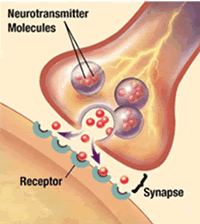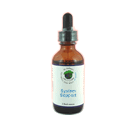|
|
Neurotransmitter Support Remedy
 |
Scientists used to believe that the majority of communication in the brain was electrical in nature until the discovery that there is a synaptic gap between neurons. Remember that neurons are the very elements that make up most of the brain, spinal cord and complex nervous system. Communication of information between neurons is accomplished by movement of chemicals called neurotransmitters. They are released from one neuron at the presynaptic nerve terminal, then cross the synapse where they may be accepted by the next neuron at a specialized site called a receptor. In the photo you can see the pinkish dots as neurotransmitters crossing that synaptic gap and being received by a receptor on the next neuron.
Activation of a receptor site causes an action that may be either depolarization (an excitatory postsynaptic potential) or hyperpolarization (an inhibitory postsynaptic potential). Neurotransmitters are synthesized from plentiful and simple precursors, such as amino acids, vitamins and minerals. These are readily available from the diet and require only a small number of biosynthetic steps to convert.
By far the most prevalent transmitter is glutamate, which is excitatory at well over 90% of the synapses in the human brain. The next most prevalent is GABA, which is inhibitory at more than 90% of the synapses that do not use glutamate. Major neurotransmitters include: glutamate, aspartate, D-serine, ?-aminobutyric acid (GABA), glycine, dopamine (DA), norepinephrine (noradrenaline; NE, NA), epinephrine (adrenaline), histamine, serotonin (SE, 5-HT), acetylcholine (ACh), adenosine, anandamide, nitric oxide, etc.
Neurons expressing certain types of neurotransmitters sometimes form distinct systems, where activation of the system affects large volumes of the brain. Major neurotransmitter systems include:
- The noradrenaline (norepinephrine) system which is responsible for feelings of arousal and reward.
- The dopamine system is responsible for reward, as well as cognition, nausea, motor systems and endocrine system.
- The serotonin system regulates mood, satiety, body temperature, sleep.
- The cholinergic system in involved with learning, short term memory, arousal and reward.
In addition, over 50 neuroactive peptides have been found and new ones are discovered regularly. Many of these are "co-released" with a small-molecule transmitter, but in some cases a peptide is the primary transmitter at a synapse. Single ions, such as synaptically released zinc, are also considered neurotransmitters, as are some gaseous molecules such as nitric oxide (NO), hydrogen sulfide (H2S), and carbon monoxide (CO). These are not classical neurotransmitters by the strictest definition. The only direct action of a neurotransmitter is to activate a receptor. Therefore, the effects of a neurotransmitter system depend on the connections of the neurons that use the transmitter, and the chemical properties of the receptors that the transmitter binds to.
Fun Facts
- Cocaine blocks the reuptake of dopamine back into the presynaptic neuron, leaving the neurotransmitter molecules in the synaptic gap longer, eliciting a pleasurable emotional response. Drugs like cocaine, opium, heroin, nicotine, and alcohol increase the levels of dopamine. If it feels good, dopamine neurons are probably involved!
- Ritalin affects the synapse in a way that is similar to amphetamines ("speed").
- The plant poisons curare and hemlock cause paralysis by blocking the acetylcholine receptor sites of muscle cells. The well-known poison botulisum works by preventing release of acetylcholine, so Botox is used cosmetically to cause paralysis in muscles.
- Hallucinogens such as LSD, mescaline, psilocybin, and ecstasy work by attaching to serotonin receptor sites and blocking transmissions in perceptual pathways. A similar, but milder reaction occurs when you take Prozac.
- Endorphin is short for "endogenous morphine." It is structurally very similar to the opioids (opium, morphine, heroin, etc.) and has similar functions like inhibiting pain and feeling pleasure.
Health Conditions
Over 60 diseases and illnesses may be caused by or associated with neurotransmitter deficiency. Some of these include:
- ADD
- Alzheimers
- Autism and Aspergers syndrome
- Bipolar disorder
- Chronic fatigue syndrome
- Depression
- Diabetes insipidus
- Epilepsy
- Fibromyalgia
- Obsessive-Compulsive Disorder
- Panic Disorder
- Parkinson
- Premature ejaculation
- Schizophrenia/psychosis
- Sociopathy (being a sociopath)
- "Pediatric Neurotransmitter Disease" is an umbrella term for genetic disorders that affect the synthesis, metabolism and catabolism of neurotransmitters in children.
Suggestions To Strengthen
- Eat a healthy, balanced diet, particularly enough protein as neurotransmitters are made from them.
- Eliminate and then detox medications that interfere with neurotransmitters, like antidepressants, or any mood altering drug, including Ritalin.
- Avoid stimulants like caffeine and chocolate, diet pills.
- Avoid brain overload, give your mind a rest from television, stress, excess work, etc.
- Get the intestines healthy (leaky gut, constipation, IBS, etc.)
- Over exposure to sun light can interfere with healthy Serotonin levels.
- Above all, take time to meditate and pray, connect to your Higher Power.
|
|
| |
Neurotransmitters Support Remedy
Complete support remedy for Neurotransmitters and related functions
$14.95
Read/Write Reviews
|
 Add
To Cart Add
To Cart |
 |
 |
Liver Support Remedy
Complete support remedy for Liver and related functions
$14.95
|
 Add
To Cart Add
To Cart |
 |
 |
Small Intestine Support Remedy
Complete support remedy for Small Intestine and related functions
$14.95
|
 Add
To Cart Add
To Cart |
 |
 |
Large Intestine Support Remedy
Provides support and healing for conditions of the large intestine
$14.95
|
 Add
To Cart Add
To Cart |
 |
 |
|
|



